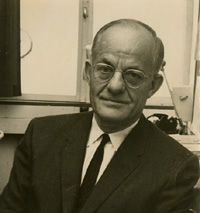John Esben Kirk (1905-1975)
Esben Kirk (he did not adopt John as a first name until 1945) was born in 1905 in Kalundborg, on the island of Sjælland, Denmark, the son of a judge and member of parliament. He studied medicine at the University of Copenhagen, receiving his M.D. in 1929. He was an assistant resident physician in the county hospital at Roskilde, in central Sjælland, from 1929 until 1931.
Kirk’s first visit to the U.S. was as a research fellow at Rockefeller Institute in New York and assistant resident physician at its hospital. While there he met Irma Louise Muser, a nurse; the two were married in 1934. Later that same year Kirk returned to Denmark to be an assistant resident physician at the hospital in Bispebjerg, a section of north Copenhagen, and to resume study at the university. He received his Ph.D. in biochemistry in 1936. From 1936 until 1939 Kirk served both as chief resident of the National Hospital (Rigshospital) and director of the city health laboratories in Copenhagen. In 1939 he was appointed chief physician of the county hospital at Holsterbro, in northwest Jutland.
Esben and Irma Kirk had four children when they moved to Holsterbro; a fifth child was born in 1941. The German invasion of Denmark in 1940 and subsequent occupation until 1945 imposed repeated threats of considerable danger to himself and his family. As head of the West Jutland Medical Society Kirk was called upon to protest actions by German authorities. At times he sheltered Danish Jews at the hospital, an action eventually noted by Nazi agents. Toward the end of the war, fearing an imminent arrest, Kirk concealed his wife and children in a contagious diseases ward of the hospital while he joined the Danish underground forces.
Following the war, Kirk took leave from his position in Holsterbro and moved with his family to New York, lodging temporarily with Irma’s parents. From there he applied for a position at Washington University, which in 1946 established a Division of Gerontology based at St. Louis Infirmary with funding from local charities. The Infirmary, located at 5600 Arsenal Street in South St. Louis, was a municipal facility operated mainly for older patients (later renamed St. Louis Chronic Hospital). Kirk was appointed director of research, moved with his family to St. Louis, and began his new position in 1947. He applied for U.S. citizenship and took the “American” first name John to denote his new nationality. In 1948 he was certified to practice medicine in Missouri by the State Board of Medical Examiners.
Along with the position at Chronic Hospital, Kirk was named assistant professor of Medicine at Washington University and an attending physician at Barnes Hospital. He set as his main research goal the study of factors pertaining to arteriosclerosis in aging, and in this received enthusiastic support of the head of the Division of Gerontology, William B. Kountz. Kountz also coordinated the funding of clinical and research programs through a local Gerontological Research Foundation. This enabled Kirk to recruit talented research associates and fellows (several of whom over the years were invited from Denmark). Irma Kirk was hired as a nurse at the hospital and her husband’s personal assistant.
Kirk was promoted to associate professor of medicine in 1951 and full professor in 1964. He became internationally recognized in his field through numerous publications and from his editorship (from 1951 until 1962) of the Journal of Gerontology. Over the years, he wrote or contributed to over 200 scientific articles and 21 books. He was particularly noted for biochemical analysis of certain processes common in aging – the role of enzymes in arteriosclerosis and the effects of hormones and vitamins. He was a member of many medical organizations in fields relating to gerontology and cardiology and spoke often at scientific meetings in the U.S. and in Western Europe. Along with Kountz and professor of anatomy E.V. Cowdry, Kirk was regarded as one of Washington University’s leading authorities on human aging. Kirk succeeded Kountz as head of the Division of Gerontology in 1962.
A serious disadvantage to the division was that it remained based at Chronic Hospital, which the city of St. Louis failed to renovate substantially over the years. Passage of the Medicare Act in 1965 meant that senior citizens of modest income were less dependent on “infirmaries” at the very time when municipal finances could no longer sustain such traditional “charity” institutions. Although Kirk and his principal associates remained committed to the research and treatment programs that they operated, no means were offered to transfer them to the Washington University Medical Center, proper.
Kirk retired in 1973 as did Irma Kirk. Washington University announced the closing of the Division of Gerontology shortly thereafter. Kirk died at his home in suburban St. Louis in 1975.

Related Resources:
Back to Biographies

